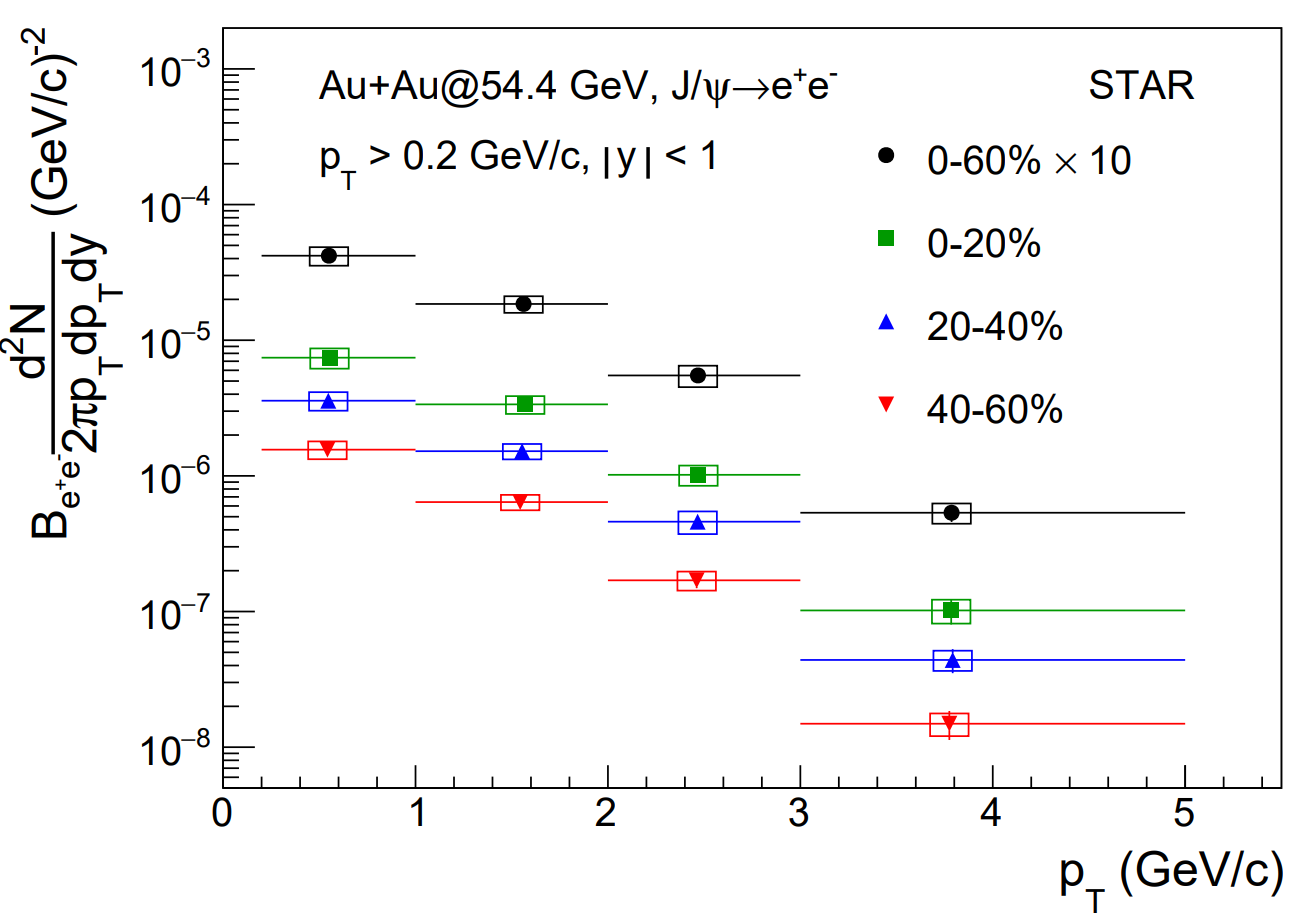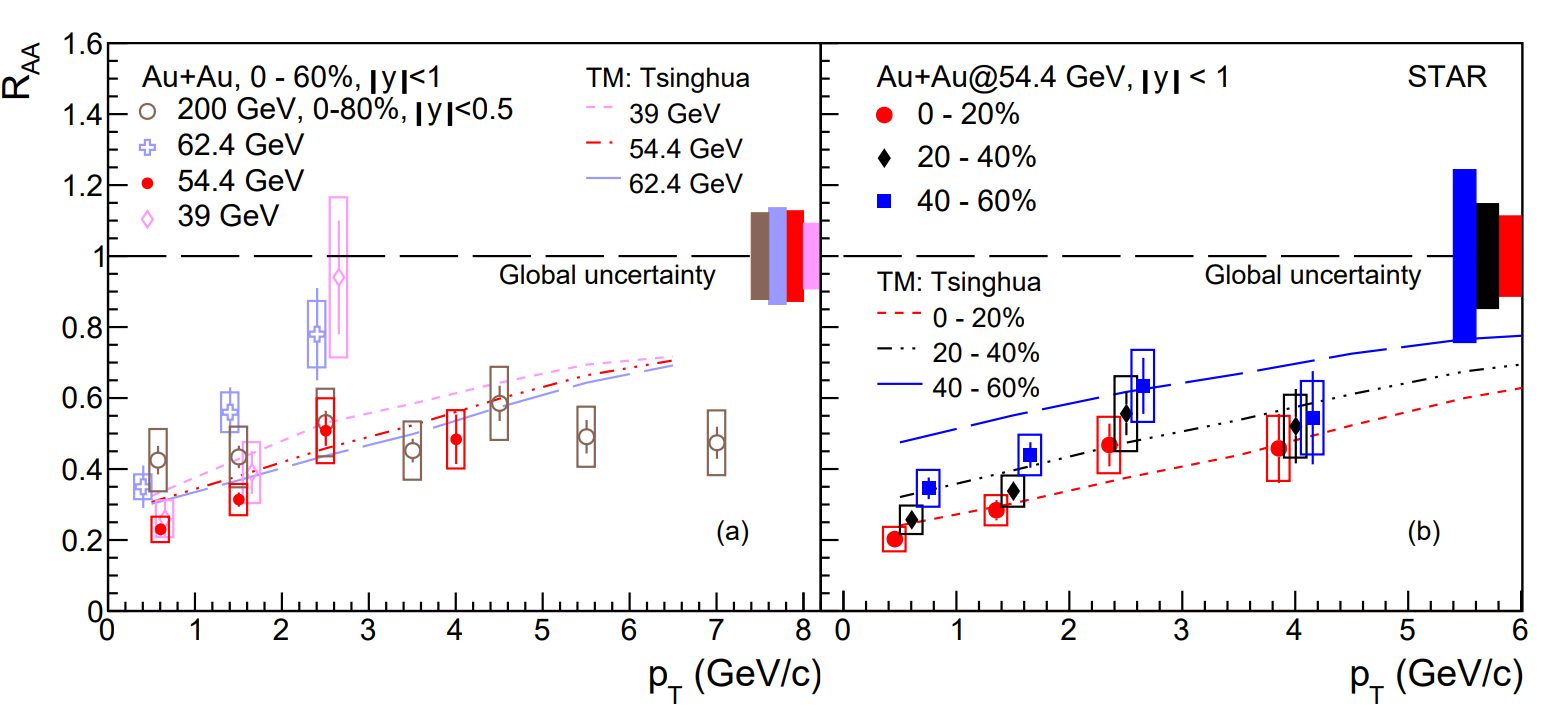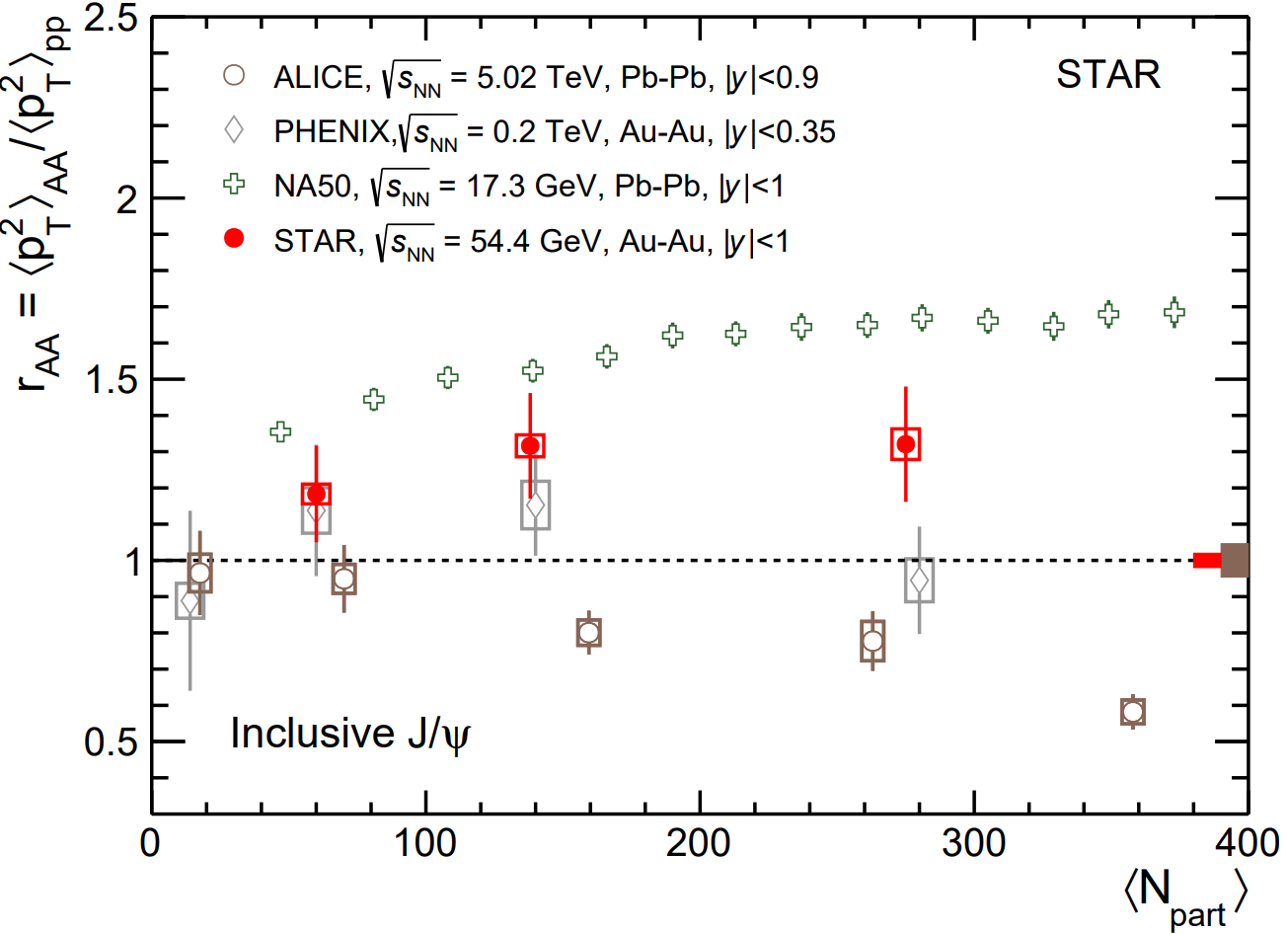J/psi production in Au+Au collisions at 54.4 GeV
Measurement of J/psi production in Au+Au collisions at √sNN = 54.4 GeV with STAR experiment
PAs: Yuanjing Ji, Rongrong Ma, Kaifeng Shen, Zebo Tang, Wangmei Zha
Target Journal: Phys. Lett. B
Abstract:
We present the measurements of inclusive J/psi production at midrapidity (|y| < 1.0) in Au+Au collisions at √sNN = 54.4 GeV with the STAR detector at the Relativistic Heavy Ion Collider. A suppression of J/psi production is observed in Au+Au collisions at √sNN = 54.4 GeV comparing to the scaled production in p+p collisions. The dependences of nuclear modification factor (RAA) on centrality and transverse momentum (pT) are measured with improved precision compared to previous measurements at 39 and 62.4 GeV. No significant energy dependence of RAA is found within uncertainties up to 200 GeV. The comparision to model calculations is presented and its physical implications are discussed
Figures:
|
|
| Figure 1. Invariant mass distributions of J/psi candidates for 0 < pT < 10 GeV/c reconstructed via the di-electron channel for | y | < 1. The black open circles are unlike sign from same event; The blue triangles are like sign from same event; The red line stands for the combinatorial background from unlike-sign mixed-event, and the black full squares are di-electron signal with the combinatorial background subtracted. The J/psi signal shape from embedding with additional momentum smearing is used to fit the di-electron signal and the residual background is described by a straight line. |
|
|
| Figure 2. J/psi invariant yields in Au+Au collisions at √sNN = 54.4 GeV as a function of pT for different centralities. The error bars represent the statistical uncertainties. The boxes represent the systematic uncertainties. A pT > 0.2 GeV/c cut is added to exclude coherent photon induced production. |
|
|
| Figure 3. The RAA of inclusive J/psi as a function of Npart in Au+Au collisions at different collision energies at mid-rapidity. The error bars represent the statistical uncertainties. The boxes represent the systematic uncertainties. The shaded bands on the data points indicate the uncertainties from the nuclear overlap function TAA. The bands around unity indicate the uncertainties from the p+p baselines. Suppression of the J/psi production is observed in Au+Au collisions at 54.4 GeV with improved precision compared to previous results at 39 and 62.4 GeV. |
|
|
| Figure 4. The Rcp of J/psi as a function of centrality. The error bars represent the statistical uncertainties and the boxes represent the systematic uncertainties. There is no significant energy dependence within uncertainties at RHIC energy. |
|
|
| Figure 5. The RAA of J/psi as a function of collision energy for central collisions, in comparison with model calculations. The error bars represent the statistical uncertainties and the boxes represent the systematic uncertainties, including those from p+p baselines and uncertainties from TAA. There is no significant energy dependence within uncertainties from SPS to RHIC top energy. |
|
|
| Figure 6a. The inclusive J/psi RAA as a function of pT in Au+Au collisions for different collision energies in 0-60% centrality. Figure 6b. The inclusive J/psi RAA as a function of pT in Au+Au collisions for different centrality bins at 54.4 GeV. The error bars represent the statistical uncertainties. The boxes represent the systematic uncertainties. The bands around unity indicate the uncertainties from the TAA and the p+p baselines. A larger suppression is observed at lower pT and towards more central collisions. |
|
|
| Figure 7. The inclusive J/psi rAA as a function of Npart in different collision systems at mid-rapidity. The error bars represent the statistical uncertainties. The boxes represent the systematic uncertainties. The rAA distribution at 54.4 GeV follow the trend of collision energy dependence. |
Summary:
In summary, we report on measurements of J/psi meson production in Au+Au collisions at √sNN = 54.4 GeV with the STAR detector at RHIC.
- The Npart dependence of RAA show a suppression in central Au+Au collisions at √sNN = 54.4 GeV
- Newly measured RAA for J/psi meson at √sNN = 54.4 GeV is shown as s function of Npart and pT with improved precision compared to previous measurements at 39 and 62.4 GeV, within current uncertainties, no significant collision energies dependence at RHIC hais been observed
- Newly measured Rcp for J/psi meson at √sNN = 54.4 GeV is shown as s function of Npart with improved precision compared to previous measurements at 39 and 62.4 GeV, no significant collision energies dependence has been observed.
- No significant energy dependence of RAA in central collisions from 17.2 to 200 GeV within uncertainties is observed
- A larger suppression is observed at lower pT and towards more central collisions
- The mean pT square and rAA distributions at 54.4 GeV follow the trend of collision energy dependence
Institution comments:
For RU institutional comments:
For UKY institutional comments:
For AUC institutional comments:
For TAMU institutional comments:
GPC REVIEW:
Discussion in HP pwg meeting on Ferbuary 20,2025/:
Second GPC meeting on October 29, 2024:
Second GPC meeting on October 29, 2024:
Replies to Petr's comments:
Replies to Nihar's comments:
Janet's comments:
PWG REVIEW:
Replies to Nihar's comments:
Replies to Yi's comments:
Related presentations:
Here is a summary of links about related presentations on pwg meeting.
Analysis note:
Here is the link of analysis note.
Paper draft:
Here is the link of paper draft.
- kshen's blog
- Login or register to post comments







